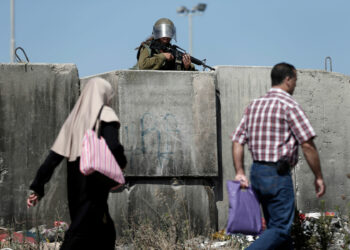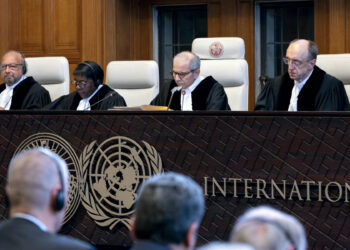John Tirman, a DAWN fellow, is the executive director and principal research scientist at the MIT Center for International Studies. He is coauthor of Republics of Myth: National Narratives and the U.S.-Iran Conflict (Johns Hopkins University Press).
The impasse in the negotiations to revive the Iran nuclear deal is not surprising. The situation is fraught in both Washington and Tehran, with mistrust of the other 43 years in the making since the revolution that established the Islamic Republic of Iran. The ill will is deeply entrenched in each country's political culture—specifically, in each one's national narrative, which guides and embeds the animus besetting the relationship.
National narratives are the stories we tell ourselves about our country. They rely on some facts, often embellished, combined with myths and legends that provide a sense of national identity. They work subtly through education, news media, entertainment, popular history, government propaganda and other means. They tend to frame political choices and thereby exert unusual power on official policy, foreign and domestic.
Iran and the United States have sharply different national narratives, and that is one dominant reason why they have such difficulty talking to each other, much less agreeing on important matters like nuclear weapons. These narratives are, moreover, steeped in images and practices of violence, undermining any kind of conciliation.
Iran's national narrative is generally split into two stories. The first, and the one preferred by the Islamic Republic, is based on the martyrdom of Imam Hussein in 680 C.E, in Karbala, in modern-day Iraq. The grandson of the Prophet Muhammad, Hussain was betrayed and killed in a battle with his Sunni rivals over who succeeded his grandfather. The battle fueled the schism between Sunni and Shia Islam.
The second national myth, which sits uneasily with the first but is still popular, is about Iran being an Aryan nation, with an unbroken lineage back to Cyrus the Great and other ancient Persian heroes. The idea of the Aryan connection was invented in the late 19th century and provided Persians with a link to Europe. It was promoted by the last Iranian monarchs, the Pahlavi family, and was used in part to elevate Iran to a status above its Arab neighbors, deserving of unique respect in the global order.
Iran and the United States have sharply different national narratives that are steeped in images and practices of violence, undermining any kind of conciliation.
- John Tirman
The national narrative of the United States, by contrast, is the frontier myth, invented by the Puritans and maintained for 400 years. It aspires to tame the wilderness, vanquish its savages and reap its bounty. As the European settlers to America did just that, sweeping across the continent and wiping out the Native American population, the virtues of frontier life—freedom, cultivating the land, individualism, small-"d" democracy—took hold as fundamental American values. When the frontier in the western United States closed near the end of the 19th century, America's frontier moved abroad to the Philippines, the Caribbean, Latin America, Southeast Asia and the Middle East—all enforced, as continental expansion was, by military and settler violence.
These national narratives have shaped to an important degree the U.S.-Iran relationship. America's frontier myth is expansive, filled with Christian moralism at the same time it was enabled by systematic violence. This American frontier has been actively expanding in the Middle East, including in Iran, for nearly 70 years.
For centuries, Iran was controlled by foreigners—Arabs, Turks, British—and this humiliation, symbolized by Imam Hussein's defeat, still shapes the thinking and ideology of Iranian leaders. Their rejection of foreign influence was an underlying motivation for the revolution against the Western-backed Shah and everything that has followed. This rejection is often in the form of violence—perhaps most aggressively in response to the disastrous U.S.-led invasion and occupation of Iraq in 2003, a war that led to as many as one million fatalities. Iran's Islamic Revolutionary Guard Corps actively sought to thwart the U.S. mission, likely killing hundreds of American soldiers and helping foment the civil war that devastated Iraqi society.
The current impasse in the negotiations to restore the Joint Comprehensive Plan of Action, or JCPOA, as the nuclear deal is officially known, and enact new nuclear restraints on Iran are a reflection of these clashing narratives. American elites of both Republican and Democratic parties believe the U.S. has the right to impose restrictions on Iran that are not applied to other countries with nuclear capabilities. If the nuclear deal cannot be revived, violence is threatened—all options, in the bone-weary phrase, are "on the table." Violence has been employed already to stunt Iran's nuclear progress via assassinations of nuclear scientists and acts of sabotage. Under former President Donald Trump, the U.S. killed one of Iran's most revered leaders of the Revolutionary Guards, Qasem Soleimani, with a brazen drone strike in Baghdad in January 2020.
Violence is not only built into the relationship, but so is the potential for betrayal—whether Iranian "cheating," as many opposed to the nuclear deal foresee, or the next U.S. president withdrawing from the agreement like Trump did.
- John Tirman
Iran still threatens and carries out violence, mainly through the Quds Force of the Revolutionary Guards that Soleimani once led. This has become the sticking point for sealing a new nuclear deal, because President Joe Biden's administration has insisted that Trump-era sanctions on the Revolutionary Guards remain in place, while Iran demands relief from those sanctions.
A deal may still be struck because the money involved is so large for Iran: $100 billion or more in frozen revenues abroad, mainly from oil sales, as a result of reimposed sanctions under Trump. Other sanctions will come off, helping Iran's financial sector particularly. U.S. interests in a deal revolve around the restraints on Iran's nuclear program, which Tehran says is for civilian purposes only, and further hopes for stability in the region and help with oil markets amid the war in Ukraine.
Even with a new nuclear agreement, however, the intense hostility between Iran and the U.S., and the deeply embedded narratives that fuel it, will persist, threatening the deal's longevity. Violence is not only built into the relationship, but so is the potential for betrayal—whether Iranian "cheating," as many opposed to the nuclear deal foresee, or the next U.S. president withdrawing from the agreement like Trump did. Other flash points provide opportunities for conflict, particularly Iraq, but also Yemen, where the Houthis, who are backed by Iran, are in a vicious war with Saudi Arabia and the United Arab Emirates, both lavishly supported by Washington precisely because they are battling Iran by proxy. In fact, that American support was essentially a payoff to the Saudis after the 2015 Iran deal, which the Obama administration struck over fierce objections from Riyadh and Abu Dhabi. And, of course, Israel's years-long threats to attack Iran's nuclear facilities have not subsided.
National narratives do not grip foreign policies with unyielding force. National interests obviously play a prominent role in any calculation of U.S.-Iran relations. It is striking, then, that for both countries, their own interests have long taken a back seat to the two dueling political cultures shaped by their divergent narratives and the violence they foster. This is not good news for those hoping that another breakthrough on nuclear restraint would produce a better relationship between Washington and Tehran, even a normalized one. It will not—not now and not for many years to come, if ever. The narratives don't allow it.







